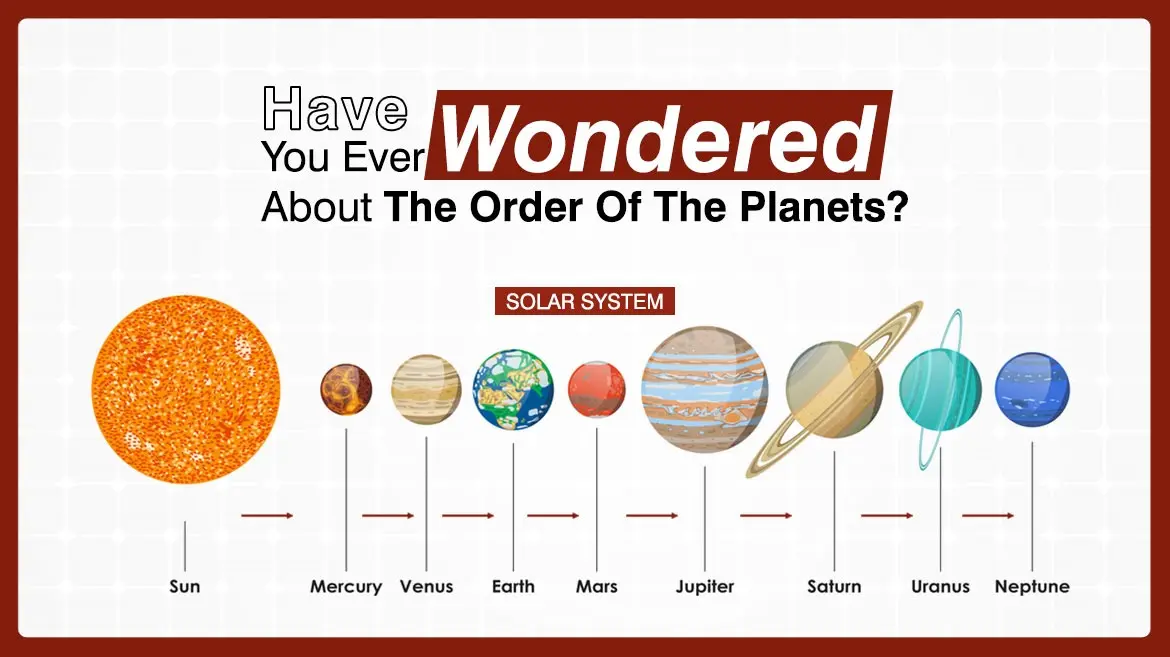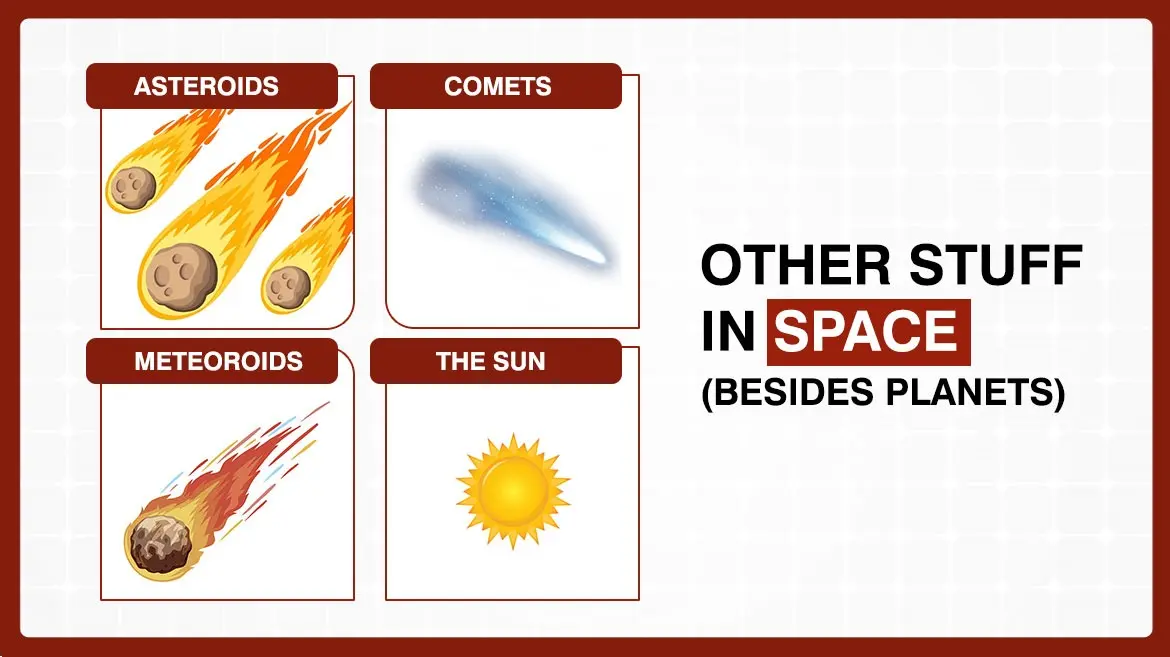Solar System Guide: Planets in Order and Fun Space Facts
The solar system is a concept people encounter in school, but most people don’t explore beyond its names and charts. This blog aims to simplify it using real concepts instead of complex science, including easy explanations and fun details to share.
Every component from Mercury to Neptune (even Pluto) has unique stories which we aim to discover in this guide. Planets, moons, and asteroids will all be explored in a soothing, friendly manner that makes space feel easy.
Have You Ever Wondered About The Order Of The Planets?

Have you ever found yourself forgetting the order? There is a really easy trick that goes like this, My Very Educated Mother Just Served Us Noodles.
This is what it translates to:
1. Mercury
Closest to the Sun. Day time temperatures are always scorching while freezing temperatures take over at night. Small and rocky in composition.
2. Venus
Similar to Earth in size, but engulfed by thick poisonous clouds. It is the hottest planet.
3. Earth
The only home we have. Filled with life, water, and perfect distance from the sun.
4. Mars
Looks reddish, and is cold and dry. It also has the largest canyon and the tallest volcano.
5. Jupiter
The biggest planet. It has a famous red storm and many moons. It is also a gas giant.
6. Saturn
Has stunning rings, which are primarily composed of ice.
7. Uranus
Rotates on its side. The color is pale blue due to Methane gas.
8. Neptune
The farthest from the Sun, also a deep blue. Cold and windy.
Where Did Pluto Go?
In 2006, it was reclassified as a dwarf planet, which striked away it’s title as the ninth planet. That’s because it didn’t clear it’s orbit of space rocks. Everyone still finds Pluto intriguing due to its five moons, one of them being Charon which is almost the same size as Pluto!
Even without being classified as a full planet, it is still cherished by space enthusiasts and studied by astronomers.
Other Stuff in Space (Besides Planets)

The rest of the solar system holds more than just planets. Other important portions includes:
- Asteroids - Large rocks that mostly drift between Mars and Jupiter.
- Comets – As ice and dust are drawn closer to the sun, they glow and release long tails.
- Meteoroids – Space rocks that are small in size. When they burn up in the Earth’s atmosphere, they are called meteors. If parts of them hit the ground, those fragments are called meteorites.
- The Sun – It is not a planet, because it is the center of everything. It holds the cosmos with its gravity, and gives light and warmth.
In the solar system everything is in constant motion, planets revolve around the sun, moons orbit planets, and even asteroids and comets are in pathways etched out by gravity.
Some Planets Have Moons (Many of Them!)
Let’s start with moons, Earth has one, but other planets have many:
- Earth – One moon, but it plays an crucial function as it helps control tides and illuminates the night sky.
- Mars – Small and tiny moons Phobos and Deimos that are in the shape of a peanut.
- Jupite – Over 90 moons, it also has the biggest moon in the solar system Ganymede.
- Saturn – Also is in possession of 80 plus moons which also holds Titan. Titan has thick clouds and lakes consisting of methane.
- Uranus and Neptune – Each have more than a dozen moons, icy and small in size.
Moons can be very different. Some might be rocky while others are icy, or some may even have underwater oceans.
Planet Rings? More Than Just Saturn!
“Ringing” is often associated with Saturn, but he certainly isn’t the only one wearing a ring. All four gas giants: Jupiter, Saturn, Uranus and Neptune, possess rings. Gas gulfs have varying ring qualities, with Jupiter having faint rings while Saturn’s are bold and wide, and Uranus and Neptune have thin, dark rings.
Rings are composed of particles such as ice, rocks, and dust. It is hypothesized by scientists that they could be fragments of broken moons or comets.
Did You Know? (Cool Space Facts)
Here are some space facts that are sure to pique your interest:
- It takes approximately 165 Earth years for one single year on Neptune.
- Venus rotates in the opposite direction to most other planets.
- Mars experiences seasons similar to Earth, but they last for an extended period of time.
- Unlike the rest of the planets, Uranus is the coldest planet even though Neptune is farther away.
- The Sun will continue shining for 5 more billion years, making it around 4.6 billion years old.
- You would only weigh 19 kg if you were 50 kg on Earth.
- Jupiter has wantonly been enduring centuries of storms, with The Great Red Spot measuring far greater than Earth.
Why Learn About This Stuff?
Learning about space is not only for scientists, Space assists in understanding Earth better. Studying other planets gives us great insight into how weather functions, climate changes, and what may happen to our world.
Moreover, wondering what is “out there” provides an extra dose of fun. While looking at the stars or waving the Moon hello, waiting for an upcoming space expedition, knowing more about the solar system enhances the thrill.
Even something like solar energy, which is utilized on Earth, stems from understanding the Sun and a lot of modern-day technology was tested in space prior.
And for many children and students, the basics of science-imaginary revolve on learning about planets. It nurtures curiosity and imagination, fostering creativity.
FAQs
Q: Is Mercury the hottest planet?
A: No Venus is hotter, Mercury is closer to the Sun but lacks atmosphere to store heat.
Q: How many planets are in the solar system?
A: Eight planets with a couple of dwarf planets like Pluto.
Q: Why does Uranus spin on its side?
A: A long time ago, it was most likely struck by something large which caused the knock over.
Q: Which planet is the largest?
A: Jupiter is the largest, and it is over 1,000 times larger than Earth.
Q: Will humans be able to inhabit Mars?
A: Not now, but it is something scientists are hoping to conduct research on in the future. Mars remains extremely cold and lacks breathable air.
Q: Why don’t planets float away?
A: They don’t float away because the Sun’s gravitational pull keeps them in orbit. You could say there are invisible strings keeping them close.
Q: Are there other solar systems anywhere like ours?
A: There are many other solar systems located throughout the galaxy. Some of these solar systems could possibly have planets that resemble Earth.
Final Thoughts
The solar system contains many other fascinating places. Each planet offers something special, such as Mercury's extreme heat or Neptune's freezing winds. Although we consider Earth our planet home, it is always nice to have strongly spatial surroundings.
Whenever you look at the moon or read about a space mission, you will have a better understanding of how things work. Space might feel distant, but there is a lot of learning to do. Space is very intriguing, and there will always be new things to explore, whether you are interested in science or outside the world.
